Logitech MX Brio 4K Webcam
Logitech’s latest 4K webcam is remarkably good for low-light settings and performs even better in a well-lit room. Sporting a completely transformed design and a sturdier build, it doesn’t look anything like its predecessor. And its dual noise-reducing mics do their job extremely well. You won’t get an IR sensor like you did on the older 2017 Brio. Also, the setup is slightly complex because of the camera’s heavy weight.
Pros
Excellent low-light performance
Crisp image quality with lots of detail, texture, clarity, and sharpness
Mics cancel ambient noise extremely well
A beautiful, refined design and robust build
Cons
No longer features an IR sensor
The mics make you sound tinny and sharp
The setup is a bit fiddly
Companion software doesn’t feature enough bells and whistles
If you know anything about webcams at all, you’d be familiar with Logitech’s Brio line, which has been the top choice for most professionals for the ideal work-from-home setup. And if you’ve ever been in the market for enterprise-level mice or keyboards, you’ve probably seen Logitech’s MX line among the top few results. In a recent move, Logitech married the two brands, which gave birth to the MX Brio webcam. This means you get all of the Brio goodness enhanced with the productivity-focused nature of the MX series.
This isn’t the company’s first time bringing 4K to its webcam. The good, old Logitech Brio from 2017 also offered shooting in 4K. Apart from a completely refined design and, of course, a bunch of AI stuff, what’s new is an increased sensor size. You get an 8.5MP sensor on this one, which Logitech promises translates to a 70% increase in pixel size and, ultimately, “two-times finer image detail.”
Pixel size is one of the primary factors for good low-light performance. So, that’s the premise upon which my expectations of the MX Brio were based. And it passed with flying colors. Even with my curtains drawn and lights turned off, my face showed up pretty well-lit only with the help of the light emanating from my laptop’s display.
Shockingly good in low-light settings
Despite going in with pretty high expectations of how well this is going to perform in low light, I was pleasantly surprised. For some context, I made my room dark enough not even to be able to make out the products on my dressing table. And even then, my face was visible, detailed, sharp, and clear on the MX Brio. There was a bit of a loss of sharpness in the darker areas of my room—the parts that weren’t as illuminated as my face seemed slightly pixelated—but nothing too concerning.
What makes me give this webcam the low-lighting champion award is the fact that it doesn’t just make your face visible in a dark room; it does that with the kind of crispness where you can clearly see the texture of your skin and tell every strand of your hair apart. I guess it’s safe to say that the larger pixel size isn’t just a marketing gimmick. Any camera nerd would agree, too, since larger pixels are able to gather more photons because of bumps in the surface area. More photons mean more photoelectrons are formed, ultimately increasing the sensor’s light sensitivity.
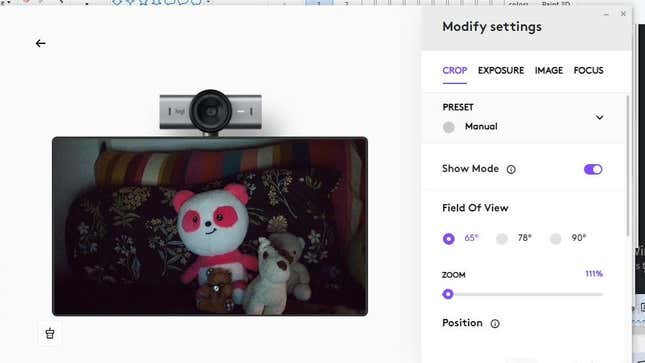
The MX Brio performs even better in a regular, well-lit room. The attention to detail is fascinating, with, sadly, every flaw of your face standing out. The mirror in my room, which I haven’t deep-cleaned in a while, didn’t inform me about the tiny breakout on my forehead the way this webcam did. The MX Brio captures textures beautifully. It gave the pillows and blankets behind me enough definition so they didn’t appear flat.
Saying this thing makes everything look great is stating the obvious when the specs—8.5MP sensor, 4K at 30 FPS, 1080p at 60 FPS, ultra-wide lens—attest to that. But if you still need some context, take the OG Brio’s performance and make it even better.
While we’re comparing this to the 2017 Brio, it’s important to discuss removing the IR sensor from the 2024 model. I’m confused about why they’d take away a crucial sensor—and the ability to log in via Windows Hello—on a newer, more advanced iteration when it was offered on a seven-year-old model. But yeah, no biometric logging in on this one.
A complete design overhaul
The new Brio looks so much better than its predecessor. It’s gotten a fully-transformed look with a metallic, cylindrical body and a huge lens in the center. The build gives off a polished, premium feel, and even some of the $300 webcams on the market don’t come close to what you get on this one for $200.
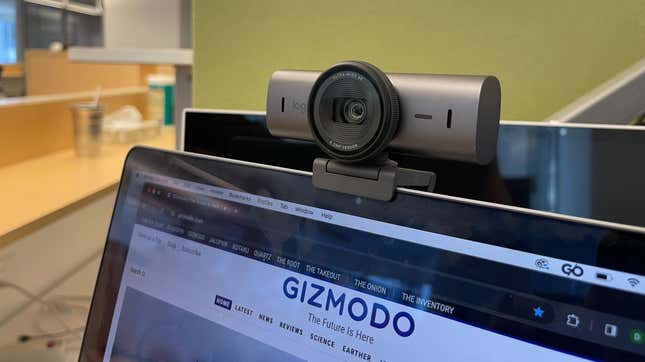
The lens features a privacy shutter controlled via a movable wheel that surrounds it. This is easily one of my favorite specs on this camera. The wheel offers a ridged exterior for better grip and allows you to turn it anti-clockwise or clockwise to open and close it. It does both with an extremely satisfying click.
There’s also a glass protector on the lens, an LED light on the gunmetal part to notify you when the device is in action, and a pair of mics. The rear is slightly less pretty, featuring a plastic front with a USB Type-C port.
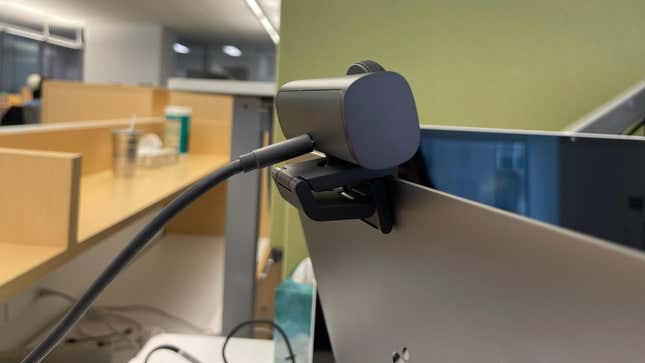
As much as I love the MX Brio’s clean, refined look, I have to add that it’s done with a huge compromise on weight. This thing is heavy. The past model weighed just 63 grams, so at 137 grams, the MX Brio feels hefty.
This made the setup a little fiddly. When you include the mount, it weighs a whopping 176 grams, so it took me a while to adjust its weight on my slim, fragile laptop display. Even then, there were a few mishaps, and the whole setup fell apart in a second.
Like the webcam, the accompanying Type-C cable is also very bulky. I don’t see cables as thick as this anywhere these days except for maybe the rear side of a TV. While it does make your desk look ugly, it also helps by doubling as a counterweight for the camera so it doesn’t fall forward on your keyboard. I still found myself fearfully tiptoeing with the MX Brio, especially while panning it.
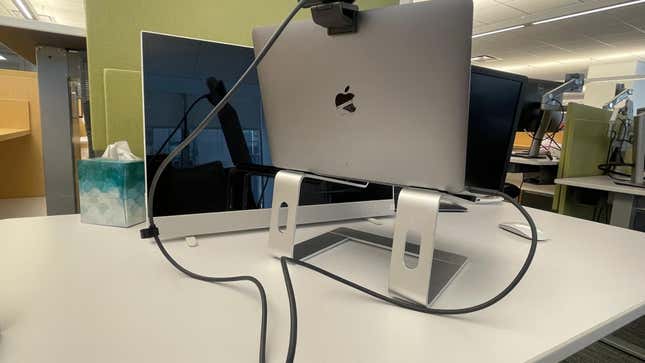
Excellent noise canceling
I put the MX Brio through various noise-canceling tests, which performed great on every single one. It completely muted my loud heater and the extremely noisy kids at the preschool playground I live near. Trust me, both things are louder than you think, and I’ve had multiple people on the phone complain about the kids. I assumed its strength lies in far-off sounds, so I put a tower fan on max right next to it, but I still didn’t hear anything. To test a high-pitched sound, as opposed to the low-end hum of the fan, I aggressively typed gibberish on my keyboard, and the recording still sounded completely clean.
The dual beam-forming noise-reducing mics with some AI noise-canceling algos powering them did exceptionally well at silencing my surroundings. Still, I’m not a huge fan of the voice quality. The mics make you sound hollow and tinny. There isn’t just a lack of bass; your voice also gets unexpectedly sharp at random moments. Most streamers who invest in a high-end webcam will probably have a dedicated mic so that I won’t worry too much about this one.
Just the barebones
It’s great that there’s dedicated companion software for everyone. There’s Logi Options+ for streamers, G Hub for gamers, and Logi Tune for businesses. However, these offer the bare minimum. Logi Options+ allows you to pick a Field Of View from the usual 90, 78, and 65 degrees. It also lets you tweak things like shutter speed and ISO, or you can turn auto-exposure on and let the software do the tweaking.
Then, you have all the standard image controls like temperature, brightness, contrast, saturation, vibrance, and sharpness. There are toggle controls for low light compensation, auto white balance, autofocus, and HDR. And Show Mode, when enabled, automatically flips the camera view so that whatever you’re showing on your desk isn’t inverted when you pan the camera downwards. Except for the Show Mode, these are all pretty standard. Some filters or background blur would have been nice, especially since platforms like Google Meet and Zoom do a terrible job of them.
Should You Buy the Logitech MX Brio?
For $200, the MX Brio is an excellent webcam I’d definitely recommend. It does a great job in dim settings and cancels noise pretty well. You sometimes sound high-pitched and annoying, but assuming you probably have a dedicated mic with this setup, that will be taken care of. It sucks that they removed the IR sensor, so a huge functionality—facial recognition— is gone. But that alone shouldn’t come in the way of investing in this gorgeous webcam with brilliant performance.



















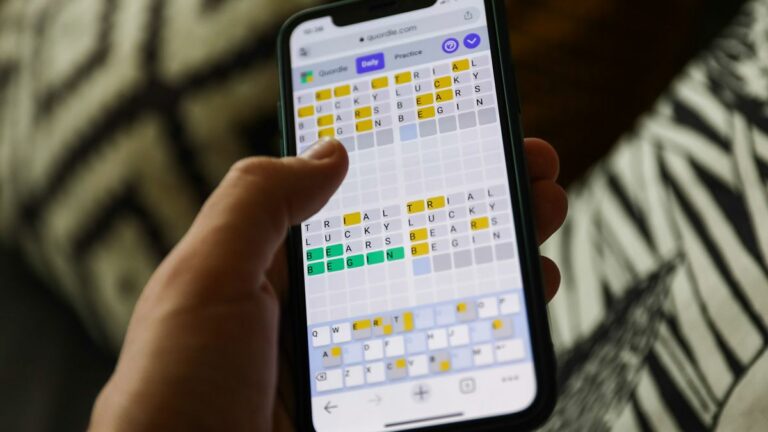
+ There are no comments
Add yours